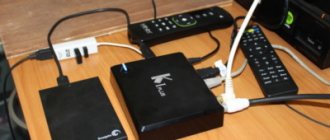In 2021, Russia must switch to digital broadcasting and abandon analogue television.
This means that it will no longer be possible to pick up a signal with a home antenna and many will have to purchase additional devices in order to continue watching over-the-air TV channels. You might exclaim “Come on!” Who’s watching this box in 2019?”, but you’ll be wrong. Television today has a multi-million audience and the vast majority of the country’s residents trust information from broadcast channels. Although in a certain sense you are right - with analog switching off, nothing will change for many; in large cities, digital penetration reaches 90%. Some people don’t have a TV at home at all; many have switched to watching broadcasts via the Internet or smartphone.
Russia’s abandonment of analogue television broadcasting in favor of a more modern digital format was provided for by the federal target program “Development of television and radio broadcasting for 2009-2018”, adopted back in 2008. Residents of Tver and the region have already become pioneers - on December 3, 2021, a pilot project to turn off the analogue began. The first stage of analogue shutdown began today, February 11th.
According to the schedule published on the website of the Ministry of Digital Development, Communications and Mass Communications of the Russian Federation, the entire country should switch to digital this summer. The last stage is scheduled for June 3, 2021. By this time, it is advisable for Russians to have time to purchase digital set-top boxes or new television receivers that support the DVB-T2 digital broadcasting standard and the MPEG-4 video format.
And if the majority of Habr users have most likely already acquired modern equipment, now you, Habra residents, will have to explain to your grandparents why they still have to throw their “Horizon” into a landfill. Since not everyone understands what analog TV is, let's clarify what kind of television we can have at home. There are four options – terrestrial, cable, IPTV/OTT and satellite:
- terrestrial analogue, when you do not have cable and you catch the signal using a home antenna
- terrestrial digital, when in addition to a special antenna to receive the signal you need to connect a set-top box, or the TV must have a built-in digital tuner
- cable analog, when you have a so-called “collective antenna” and a television cable is brought into the apartment and connected to the TV (the most common option. Nothing will be disconnected from you).
- cable DVB-C - the digital signal travels along the same cable in encrypted or clear form. If it is encrypted, then it is decrypted by a special TV set-top box or a CAM module.
- IPTV is a technology when the TV is connected to an IPTV set-top box. Digital television technology in data networks using the IP protocol.
- some still highlight OTT as a separate technology, but it is more a method of signal delivery than a technology. OTT (Over The Top) is the provision of services via the Internet. As a rule, this does not mean the operator’s own network, but the case when the service is provided on someone else’s network
- satellite TV – to receive this service you need to install a satellite dish and receiver. The quality of signal delivery often depends on weather conditions. In bad weather, you can easily be left without watching your favorite channels.
Free digital broadcasting today will provide access to 20 channels (multiplex) plus the 21st regional TV channel, approved by the Federal Competition Commission (FCC) for television and radio broadcasting of Roskomnadzor for each region of the Russian Federation.
Cable TV will provide you with as many channels as your cable operator's capacity allows. As a rule, this is about 60 channels. But it all depends on the equipment and network capacity of each specific operator in your home. Cable digital television broadcasting requires additional equipment (set-top boxes), but has a number of advantages - more channels, high-quality picture, the ability to watch HD channels, additional functions such as EPG (Electronic Program Guide), the ability to connect additional premium channel packages, etc. To be fair, to say that in the Russian Federation there is also a so-called open figure. Its advantages lie in a large range of channels offered without encoding and additional decoding equipment. But as a rule, cases of its provision are associated with piracy.
What will happen and why
The federal program has made it possible to build tens of thousands of repeaters that should bring digital television “to every home.”
But why not leave analog television? The fact is that in January the Russian Government will stop funding the distribution of traditional analog signals. This will automatically turn off older TVs that are not equipped with a dedicated digital tuner. There are many reasons for this. Firstly, unlike analogue, digital television does not require a wide range of broadcast frequencies. This is very important because our country is large and even now many residents of Russia, especially those who do not live in large cities, can only receive one or two TV channels, which are often broadcast with poor picture and sound quality. The transition should ensure full coverage of almost the entire territory of the country by official channels.
In addition, the number of channels that will be shown for free will increase. Today these are two sets of 24-hour digital television channels, the so-called “multiplexes”.
The first set included TV channels: Channel One, Russia 1, Match TV, NTV, Channel Five, Russia K, Russia 24, Karusel, OTR, TV Center and three radio stations - Radio Rossii, Mayak and Vesti FM. The second set of channels was determined based on the last federal competition: REN-TV, Spas, STS, Domashny, TV-3, Pyatnitsa, Zvezda, Mir, TNT, Muz-TV.
This transition is also being made because the quality of the digital signal is much higher than the analogue one. This applies to both image and sound.
Looking for government support
The transition to digital is accompanied by a reduction in advertising budgets. In the first quarter, the Association of Communication Agencies of Russia (AKAR) recorded a drop in advertiser spending on television advertising for the first time since the 2014 crisis. The market volume decreased by 6%, to 41.5–42 billion rubles. As explained by AKAR and the National Advertising Alliance (NRA), one of the reasons is that, against the backdrop of falling household incomes, advertisers prefer to invest in marketing, in particular in promotions.
The terrestrial signal in Russia is currently received by less than 1/5 of the population, and in the regions cable and satellite operators occupy a large share in the distribution of the signal, IPTV is developing, say the NRA. “That is, channels that are not included in digital multiplexes have alternative options for distributing their television content,” the NRA believes. Due to the shutdown of analog in 2019, there has not yet been any noticeable jump in spending on regional television advertising - the effect of the transition to digital is quite distributed over time, the alliance says. Before the transition to digital, in any city, an advertisement for a local brand could be inserted into a regional advertising block, but now, within the same frequency zone, the signal (and the content of the advertising blocks) must be the same - otherwise the picture will “scatter,” explains the director of the TV and TV department content J'son and partners Dmitry Kolesov. “For example, in the Samara region there are four large frequency zones. And a city advertiser in Tolyatti, in order to place his advertising on television, needs to overpay for showing it in other cities in the zone. It’s clear that local advertisers won’t do this,” he says. Because of this, the decline in the television advertising market will accelerate, predicts Dmitry Kolesov.
Regional broadcasters have already noticed a decline in advertising. “We feel an outflow of advertisers and see their migration to digital, although analogue broadcasting continues,” says Andrey Obukhov, general director of the Pyatigorsk media holding Simpex. In order to get digital in the region with its advertising units, the company, according to him, needs to pay RTRS 75 thousand rubles a month for 12 transmitters, that is, provide a monthly payment that is essential for it in the amount of 900 thousand rubles.
The share of regional advertising on TV, including regional inserts of federal advertisers and regional campaigns, averages about 20% annually, estimates the NRA. The general director of the RBC-TV Novosibirsk TV channel, Yuri Sluyanov, states that in the region 70-80% of advertising revenues come from Moscow products, he notes.
What to do about it?
Check what TV your parents and grandparents have. If it is connected via an antenna and not a cable, either buy a new one that supports the DVBT-2 digital terrestrial broadcasting standard, or donate a set-top box. The second option is more convenient and cheaper, since this equipment can even be connected to an analog device. The set-top box can be purchased both from providers and in household appliance stores. The connection in this case will occur via cable. Some set-top boxes can be connected via Wi-fi.
But cable also does not last forever and we, as an operator, rely on the Internet. If you have the ability to connect to your home Internet or modem, you can truly upgrade your old TV to the SMART TV level using a set-top box. The device can not only receive television channels, but also perform a number of other functions. Now we have on sale a modern set-top box Wifire TV Media Box Q5. Our service is developed based on Android AOSP and can connect to any TV.
The console itself comes with the following characteristics:
• CPU:ARM Cortex-A53, 64bit, 4 cores with a frequency of up to 2.0 GHz • GPU: Mali-450, 5 cores with a frequency of 750 MHz, • Memory: RAM - 1Gb, FLASH - 8Gb • Wi-Fi: IEEE 802.11 b/ g/n, frequency 2.4 and 5 GHz, 2 antennas in MIMO mode • Control panel: Bluetooth Low Energy • Interfaces: HDMI, AV, Ethernet, 2xUSB, MicroSD Card, S/PDIF
The set-top box operates in two bands: 2.4, 5.0. GHz both via Internet cable and Wi-Fi. The set-top box supports all video formats, even UltraHD. Compact and easily fits behind the TV.
Thus, you have the opportunity to watch for free both the usual set of TV channels of the first and second multiplex, and connect additional packages of TV channels on various topics and have access to films and TV series in high definition. This is not only TV, but also access to a huge library of content from online cinemas and more than 240 channels, but also the ability to use it as a media player - listen to music, view photos. You don’t have to buy the set-top box; you can buy it in installments. And even if there is no fixed Internet at home or in the country, the set-top box works from the mobile Internet.
Wifire TV is also presented as an application on Smart TV, smartphones and tablets through the application, while television will be available on all devices using one personal account. That is, you can watch our television even if you don’t have a TV at home.
Shutdown schedule
11 February
- Magadan region
- Penza region
- Ryazan region
- Tula region
- Ulyanovsk region
- Yaroslavl region
- Chechen Republic
April 15
- In Moscow
- In outskirts of Moscow
- Amur region
- Ivanovo region
- Kemerovo region
- Kirov region
- Kostroma region
- Kurgan region
- Lipetsk region
- Novgorod region
- Tyumen region
- Kabardino-Balkaria
- Karachay-Cherkessia
- Kalmykia
- Mordovia
- on Sakhalin
- In Stavropol
- In Udmurtia
- Chuvashia
- Yamalo-Nenets Autonomous Okrug
June 3
- In other Russian regions
So that no changes take you by surprise, today you can connect Wifire digital television. For a small amount you will receive basic and additional channel packages. Combine them at your own discretion.
FAQ
1. Due to the fact that it is planned to switch off analogue television, I decided to immediately switch to digital. Tell me, is it necessary to buy an expensive console for this? Indeed, to provide digital television via the Internet, you need to connect a special set-top box. But you don't have to buy it. Equipment can be rented for a small fee.
2. I don’t know which television to choose for my home if analog TV is soon turned off. Please tell me. The most modern option, in which you will have access to many channels with excellent quality, is digital television. To connect it you need the Internet and a special set-top box. It can be purchased or rented from Internet providers.
Tariffs can be changed by the operator. Full up-to-date information on tariffs and or by phone indicated on the website.
What's next for television?
Now we are switching to digital, perhaps the time is not far off when we will give up cable.
Cable television can be modified by replacing TV channels, but it will no longer develop, since the frequency resource has been exhausted. People have to watch 20, maximum 60 TV channels in low resolution. There are no multimedia capabilities for cable television, while digital allows you to increase the number of TV channels, improve the quality of broadcasting, and introduce new formats, thereby meeting the needs of the modern audience.
We see this as a great opportunity for operators (technology development) and benefits for people - they will be able to choose what to watch.
Television, like newspapers and magazines, will not die because everyone now has the Internet. But it will change. Television is no longer tied to place and time; it is accessible from a phone or tablet; people themselves create their own broadcast network thanks to online services for TV series and movies. We are confident that the future belongs to Internet television, which has no restrictions on the integration of new services, allows you to broadcast TV channels in high definition, and is not tied to place and time.
In the meantime, we are stocking up on set-top boxes so that our grandmothers are not left without a TV, and even better, we connect them to the Internet so that they are always in touch with you.
Normative base
A more serious area for reflection is the regulatory framework. At the moment, it is impossible to legally start broadcasting a digital radio station, since there are no necessary regulatory documents. According to Vladimir Grigoriev (president of the St. Petersburg branch of the Academy of Engineering Sciences named after A. M. Prokhorov, full member of IEEE, chief editor of the Electrosvyaz magazine, and since 2011 head of the Department of Wireless Telecommunications at ITMO University in St. Petersburg), the launch of a digital radio station Today, taking into account the increase in the time frame for commissioning facilities due to the lack of necessary regulatory documents, it will take at least 1.5 years. In addition, there is a high chance of underestimating the risks and costs of building a network, as well as designing a business model, since it should largely be determined by documents that are currently missing.
Regulatory documents required for the creation and use of digital broadcasting networks
| Document type | DAB, DAB+ | HD Radio | DRM | DRM+ | RAVIS |
| Licensing (RF PP No. 87) | Licensed communication service for broadcasting purposes. Radio frequencies are allocated on a competitive basis in cities with a population of more than 100 thousand people | ||||
| Allocation of frequency resources (solutions of SCRF for an indefinite number of persons) | Yes | No | Yes | No | No |
| Requirements for the design procedure and examination (order of the Ministry of Telecom and Mass Communications of the Russian Federation No. 101) | Requirements for the design procedure are imposed for radio transmitters with a power of more than 500 W and a communication network (fragments of a communication network) for radio broadcasting | ||||
| Requirements for commissioning (order of the Ministry of Telecom and Mass Communications of the Russian Federation No. 258) | Mandatory participation of a representative of Roskomnadzor during the commissioning of radio transmitters with a power of more than 500 W and the communication network (fragments of the communication network) of radio broadcasting | ||||
| Approval of equipment to the market (regulatory legal acts, certificate, declaration) | No | No | Yes | No | No |
| Sanitary and Epidemiological Requirements (SanPiN “Hygienic Requirements for the Placement and Operation of Radio Communication Facilities”) | The requirements are determined by SanPiN 2.1.8/2.2.4.1383-03 “Hygienic requirements for the placement and operation of transmitting radio engineering facilities” | ||||
| Payment for frequency resources (RF PP No. 171, cost calculation methods) | No practice for digital broadcasting | ||||
An attempt to adapt the existing regulatory framework to a new situation only raises additional questions. For example, if some standards allow you to transmit even a video stream over a radio channel, providing a kind of mobile television, how can you draw the line between digital television and digital radio broadcasting in the modern world, and is it worth doing? So one of the main questions in the licensing sphere is whether digital radio will be an independent market or will it become part of the existing one. And in search of an answer to this question, it is necessary not only to provide comfortable working conditions for the new market, but also not to destroy existing markets.











